#Democratic Republic of the Congo national Day
Explore tagged Tumblr posts
Text
Majority of people keep voting any Democrat/Liberal when it comes to identity of the person instead of policies.
~ Baron Tremayne Caple A.K.A. Foxy Fox/Foxy Kitsune Fox/Fox Man/Fox King/King Fox/Gemini Man/Autism Man/Rainbow Man Is A Metrosexual/God Of Autism/King Of Autism/God Of Asperger/King Of Asperger 🦊
#democrat#vote democrat#democratic socialism#democratic presidential nominee#fuck democrats#democratic republic of the congo#democratic party#democrats#democrats are corrupt#democrats will destroy america#democratic national convention#democrats lie#democrats are evil#election day#election 2024#general election#election#american elections#presidental election#election results#us elections#presidential election#president#2024 presidential race#2024 presidential election#presidental campaign#us presidents#presidential debate#presidents#vice president
2 notes
·
View notes
Text
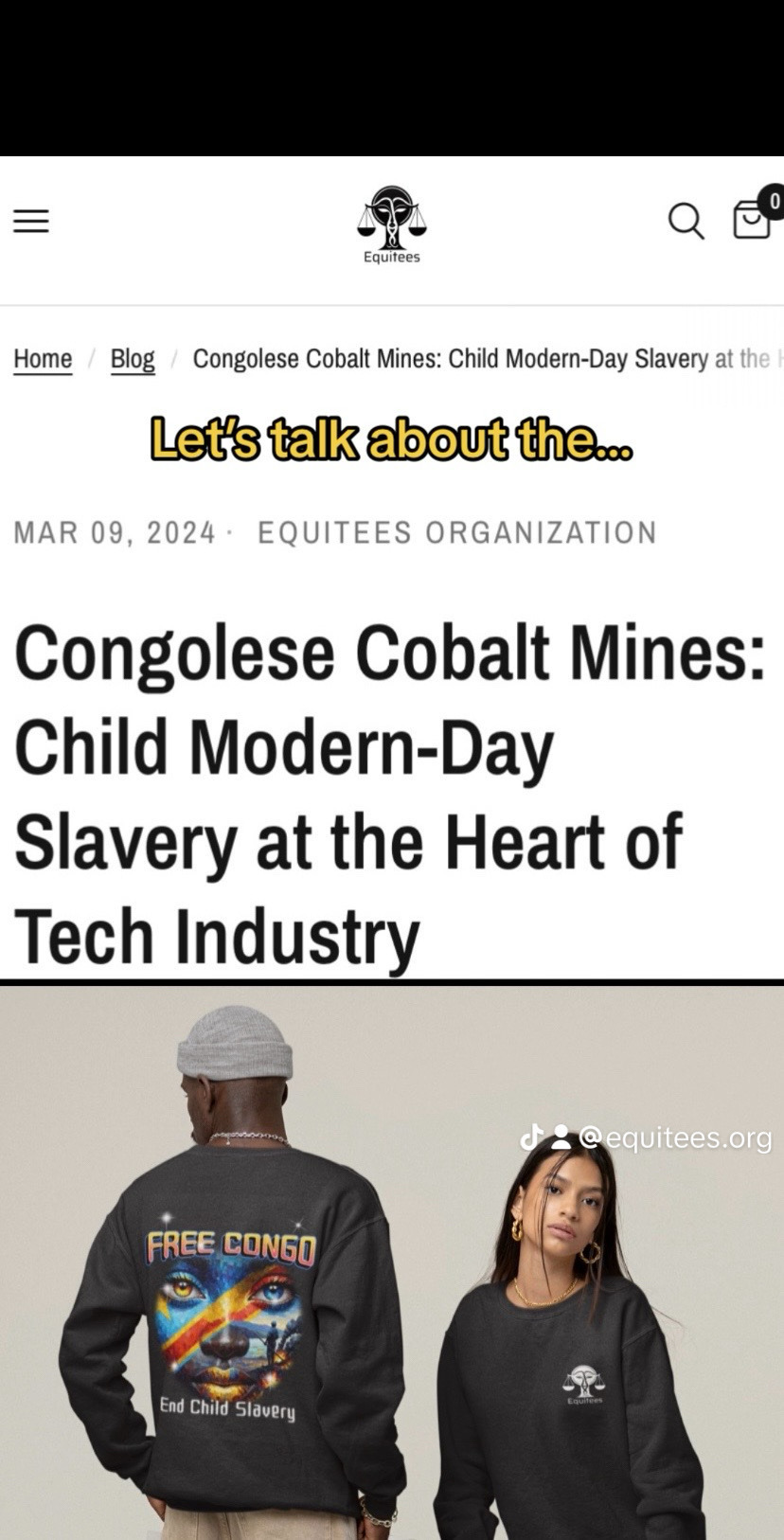
Please take the time to read and share this🙏
Together we will make a difference
For every ‘Free Congo’ item purchased, we donate directly to a globalgiving.org project dedicated to rescuing and rehabilitating these children, offering them a path towards a brighter, hope-filled future.
#free congo#help congo#congo genocide#congo crisis#democratic republic of the congo#dr congo#save congo#congolese#congolaise#congo#humanity#human rights
15K notes
·
View notes
Text
"The story of 'John Doe 1' of the Democratic Republic of the Congo is tucked in a lawsuit filed five years ago against several U.S. tech companies, including Tesla, the world’s largest electric vehicle producer. In a country where the earth hides its treasures beneath its surface, those who chip away at its bounty pay an unfair price. As a pre-teen, his family could no longer afford to pay his $6 monthly school fee, leaving him with one option: a life working underground in a tunnel, digging for cobalt rocks. But soon after he began working for roughly two U.S. dollars per day, the child was buried alive under the rubble of a collapsed mine tunnel. His body was never recovered.
The nation, fractured by war, disease, and famine, has seen more than 6 million people die since the mid-1990s, making the conflict the deadliest since World War II. But, in recent years, the death and destruction have been aided by the growing number of electric vehicles humming down American streets. In 2022, the U.S., the world’s third-largest importer of cobalt, spent nearly $525 million on the mineral, much of which came from the Congo.
As America’s dependence on the Congo has grown, Black-led labor and environmental organizers here in the U.S. have worked to build a transnational solidarity movement. Activists also say that the inequities faced in the Congo relate to those that Black Americans experience. And thanks in part to social media, the desire to better understand what’s happening in the Congo has grown in the past 10 years. In some ways, the Black Lives Matter movement first took root in the Congo after the uprising in Ferguson in 2014, advocates say. And since the murder of George Floyd and the outrage over the Gaza war, there has been an uptick in Congolese and Black American groups working on solidarity campaigns.
Throughout it all, the inequities faced by Congolese people and Black Americans show how the supply chain highlights similar patterns of exploitation and disenfranchisement. ... While the American South has picked up about two-thirds of the electric vehicle production jobs, Black workers there are more likely to work in non-unionized warehouses, receiving less pay and protections. The White House has also failed to share data that definitively proves whether Black workers are receiving these jobs, rather than them just being placed near Black communities. 'Automakers are moving their EV manufacturing and operations to the South in hopes of exploiting low labor costs and making higher profits,' explained Yterenickia Bell, an at-large council member in Clarkston, Georgia, last year. While Georgia has been targeted for investment by the Biden administration, workers are 'refusing to stand idly by and let them repeat a cycle that harms Black communities and working families.'
... Of the 255,000 Congolese mining for cobalt, 40,000 are children. They are not only exposed to physical threats but environmental ones. Cobalt mining pollutes critical water sources, plus the air and land. It is linked to respiratory illnesses, food insecurity, and violence. Still, in March, a U.S. court ruled on the case, finding that American companies could not be held liable for child labor in the Congo, even as they helped intensify the prevalence. ... Recently, the push for mining in the Congo has reached new heights because of a rift in China-U.S. relations regarding EV production. Earlier this month, the Biden administration issued a 100% tariff on Chinese-produced EVs to deter their purchase in the U.S. Currently, China owns about 80% of the legal mines in the Congo, but tens of thousands of Congolese work in 'artisanal' mines outside these facilities, where there are no rules or regulations, and where the U.S. gets much of its cobalt imports. 'Cobalt mining is the slave farm perfected,' wrote Siddharth Kara last year in the award-winning investigative book Cobalt Red: How The Blood of the Congo Powers Our Lives. 'It is a system of absolute exploitation for absolute profit.' While it is the world’s richest country in terms of wealth from natural resources, Congo is among the poorest in terms of life outcomes. Of the 201 countries recognized by the World Bank Group, it has the 191st lowest life expectancy."
3K notes
·
View notes
Text
Things Biden and the Democrats did, this week #14
April 12-19 2024
The Department of Commerce announced a deal with Samsung to help bring advanced semiconductor manufacturing and research and development to Texas. The deal will bring 45 billion dollars of investment to Texas to help build a research center in Taylor Texas and expand Samsung's Austin, Texas, semiconductor facility. The Biden Administration estimates this will create 21,000 new jobs. Since 1990 America has fallen from making nearly 40% of the world's semiconductor to just over 10% in 2020.
The Department of Energy announced it granted New York State $158 million to help support people making their homes more energy efficient. This is the first payment out of a $8.8 billion dollar program with 11 other states having already applied. The program will rebate Americans for improvements on their homes to lower energy usage. Americans could get as much as $8,000 off for installing a heat pump, as well as for improvements in insulation, wiring, and electrical panel. The program is expected to help save Americans $1 billion in electoral costs, and help create 50,000 new jobs.
The Department of Education began the formal process to make President Biden's new Student Loan Debt relief plan a reality. The Department published the first set of draft rules for the program. The rules will face 30 days of public comment before a second draft can be released. The Administration hopes the process can be finished by the Fall to bring debt relief to 30 million Americans, and totally eliminate the debt of 4 million former students. The Administration has already wiped out the debt of 4.3 million borrowers so far.
The Department of Agriculture announced a $1 billion dollar collaboration with USAID to buy American grown foods combat global hunger. Most of the money will go to traditional shelf stable goods distributed by USAID, like wheat, rice, sorghum, lentils, chickpeas, dry peas, vegetable oil, cornmeal, navy beans, pinto beans and kidney beans, while $50 million will go to a pilot program to see if USAID can expand what it normally gives to new products. The food aid will help feed people in Bangladesh, Burkina Faso, Burundi, Chad, Democratic Republic of the Congo, Djibouti, Ethiopia, Haiti, Kenya, Madagascar, Mali, Nigeria, Rwanda, South Sudan, Sudan, Tanzania, Uganda, and Yemen.
The Department of the Interior announced it's expanding four national wildlife refuges to protect 1.13 million wildlife habitat. The refuges are in New Mexico, North Carolina, and two in Texas. The Department also signed an order protecting parts of the Placitas area. The land is considered sacred by the Pueblos peoples of the area who have long lobbied for his protection. Security Deb Haaland the first Native American to serve as Interior Secretary and a Pueblo herself signed the order in her native New Mexico.
The Department of Labor announced new work place safety regulations about the safe amount of silica dust mine workers can be exposed to. The dust is known to cause scaring in the lungs often called black lung. It's estimated that the new regulations will save over 1,000 lives a year. The United Mine Workers have long fought for these changes and applauded the Biden Administration's actions.
The Biden Administration announced its progress in closing the racial wealth gap in America. Under President Biden the level of Black Unemployment is the lowest its ever been since it started being tracked in the 1970s, and the gap between white and black unemployment is the smallest its ever been as well. Black wealth is up 60% over where it was in 2019. The share of black owned businesses doubled between 2019 and 2022. New black businesses are being created at the fastest rate in 30 years. The Administration in 2021 Interagency Task Force to combat unfair house appraisals. Black homeowners regularly have their homes undervalued compared to whites who own comparable property. Since the Taskforce started the likelihood of such a gap has dropped by 40% and even disappeared in some states. 2023 represented a record breaking $76.2 billion in federal contracts going to small business owned by members of minority communities. This was 12% of federal contracts and the President aims to make it 15% for 2025.
The EPA announced (just now as I write this) that it plans to add PFAS, known as forever chemicals, to the Superfund law. This would require manufacturers to pay to clean up two PFAS, perfluorooctanoic acid and perfluorooctanesulfonic acid. This move to force manufacturers to cover the costs of PFAS clean up comes after last week's new rule on drinking water which will remove PFAS from the nation's drinking water.
Bonus:
President Biden met a Senior named Bob in Pennsylvania who is personally benefiting from The President's capping the price of insulin for Seniors at $35, and Biden let Bob know about a cap on prosecution drug payments for seniors that will cut Bob's drug bills by more than half.
#Thanks Biden#Joe Biden#jobs#Economy#student loan debt#Environment#PFAS#politics#US politics#health care
764 notes
·
View notes
Text
The Best News of Last Week - June 20, 2023
🐕 - Meet Sheep Farm's Newest Employee: Collie Hired After Ejection from Car!
1. Border Collie ejected from car during Sunday crash found on sheep farm, herding sheep

Tilly, the 2-year-old Border Collie who was ejected from a car Sunday during a crash, has been found. He was found on a sheep farm, where he had apparently taken up the role of sheep herder.
According to Tilly's owner, he has lost some weight since Sunday's crash and is now drinking lots of water but is otherwise healthy.
2. After 17-Year Absence, White Rhinos Return to the Democratic Republic of the Congo
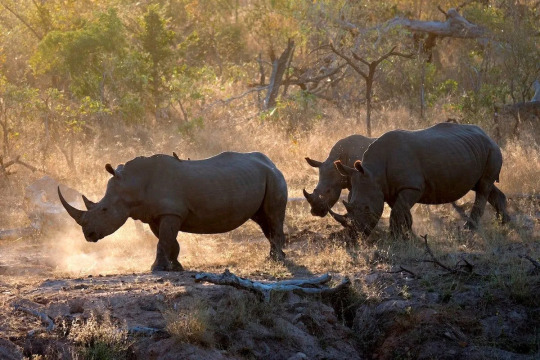
The Democratic Republic of the Congo (DRC) recently welcomed the reintroduction of 16 southern white rhinoceroses to Garamba National Park, according to officials. The last wild northern white rhino was poached there in 2006.
The white rhinos were transported to Garamba, which lies in the northeastern part of the country, from a South African private reserve. In the late 19th century, the southern white rhino subspecies was believed to be extinct due to poaching until a population of fewer than 100 was discovered in South Africa in 1895, according to WWF.
3. UK to wipe women’s historic convictions for homosexuality

Women with convictions for some same-sex activity in the United Kingdom can apply for a pardon for the first time, the Home Office has announced.
The Home Office is widening its scheme to wipe historic convictions for homosexual activity more than a decade after the government allowed applications for same-sex activity offences to be disregarded.
It means anyone can apply for a pardon if they have been convicted or cautioned for any same-sex activity offences that have been repealed or abolished.
4. Study shows human tendency to help others is universal

A new study on the human capacity for cooperation suggests that, deep down, people of diverse cultures are more similar than you might expect. The study, published in Scientific Reports, shows that from the towns of England, Italy, Poland, and Russia to the villages of rural Ecuador, Ghana, Laos, and Aboriginal Australia, at the micro scale of our daily interaction, people everywhere tend to help others when needed.
5. In a First, Wind and Solar Generated More Power Than Coal in U.S.
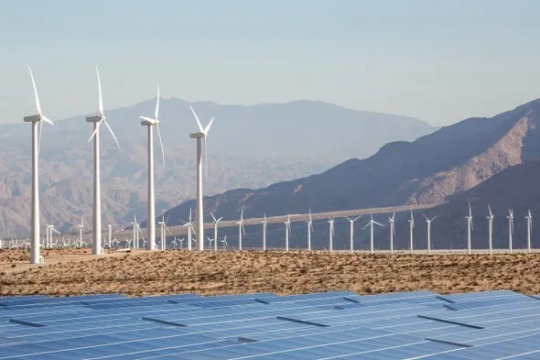
Wind and solar generated more electricity than coal through May, an E&E News review of federal data shows, marking the first time renewables have outpaced the former king of American power over a five-month period.
The milestone illustrates the ongoing transformation of the U.S. power sector as the nation races to install cleaner forms of energy to reduce greenhouse gas emissions from fossil fuels.
6. Iceland becomes latest country to ban conversion therapy

Lawmakers in Iceland on June 9 approved a bill that will ban so-called conversion therapy in the country.
Media reports note 53 members of the Icelandic Parliament voted for the measure, while three MPs abstained. Hanna Katrín Friðriksson, an MP who is a member of the Liberal Reform Party, introduced the bill.
7. The temple feeding 100,000 people a day

Amritsar, the north Indian city known for its Golden Temple and delicious cuisine, is also renowned for its spirit of generosity and selfless service. The city, founded by a Sikh guru, embodies the Sikh tradition of seva, performing voluntary acts of service without expecting anything in return.
This spirit of giving extends beyond the temple walls, as the Sikh community has shown immense compassion during crises, such as delivering oxygen cylinders during the COVID-19 pandemic. At the heart of Amritsar's generosity is the Golden Temple's langar, the world's largest free communal kitchen, serving 100,000 people daily without discrimination. Despite a history marred by tragic events, Amritsar continues to radiate kindness, love, and generosity.
----
That's it for this week :)
This newsletter will always be free. If you liked this post you can support me with a small kofi donation:
BUY ME A COFFEE ❤️
Also don’t forget to reblog.
1K notes
·
View notes
Text
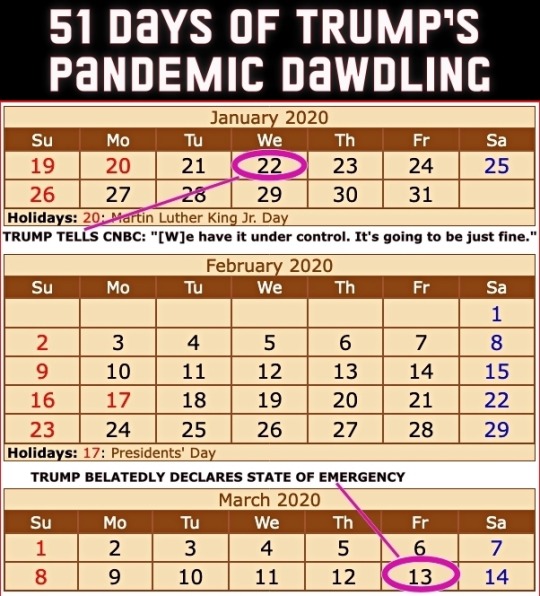
Four years ago today (March 13th), then President Donald Trump got around to declaring a national state of emergency for the COVID-19 pandemic. The administration had been downplaying the danger to the United States for 51 days since the first US infection was confirmed on January 22nd.
From an ABC News article dated 25 February 2020...
CDC warns Americans of 'significant disruption' from coronavirus
Until now, health officials said they'd hoped to prevent community spread in the United States. But following community transmissions in Italy, Iran and South Korea, health officials believe the virus may not be able to be contained at the border and that Americans should prepare for a "significant disruption." This comes in contrast to statements from the Trump administration. Acting Department of Homeland Security Secretary Chad Wolf said Tuesday the threat to the United States from coronavirus "remains low," despite the White House seeking $1.25 billion in emergency funding to combat the virus. Larry Kudlow, director of the National Economic Council, told CNBC’s Kelly Evans on “The Exchange” Tuesday evening, "We have contained the virus very well here in the U.S." [ ... ] House Speaker Nancy Pelosi called the request "long overdue and completely inadequate to the scale of this emergency." She also accused President Trump of leaving "critical positions in charge of managing pandemics at the National Security Council and the Department of Homeland Security vacant." "The president's most recent budget called for slashing funding for the Centers for Disease Control, which is on the front lines of this emergency. And now, he is compounding our vulnerabilities by seeking to ransack funds still needed to keep Ebola in check," Pelosi said in a statement Tuesday morning. "Our state and local governments need serious funding to be ready to respond effectively to any outbreak in the United States. The president should not be raiding money that Congress has appropriated for other life-or-death public health priorities." She added that lawmakers in the House of Representatives "will swiftly advance a strong, strategic funding package that fully addresses the scale and seriousness of this public health crisis." Senate Minority Leader Chuck Schumer also called the Trump administration's request "too little too late." "That President Trump is trying to steal funds dedicated to fight Ebola -- which is still considered an epidemic in the Democratic Republic of the Congo -- is indicative of his towering incompetence and further proof that he and his administration aren't taking the coronavirus crisis as seriously as they need to be," Schumer said in a statement.
A reminder that Trump had been leaving many positions vacant – part of a Republican strategy to undermine the federal government.
Here's a picture from that ABC piece from a nearly empty restaurant in San Francisco's Chinatown. The screen displays a Trump tweet still downplaying COVID-19 with him seeming more concerned about the effect of the Dow Jones on his re-election bid.

People were not buying Trump's claims but they were buying PPE.
I took this picture at CVS on February 26th that year.
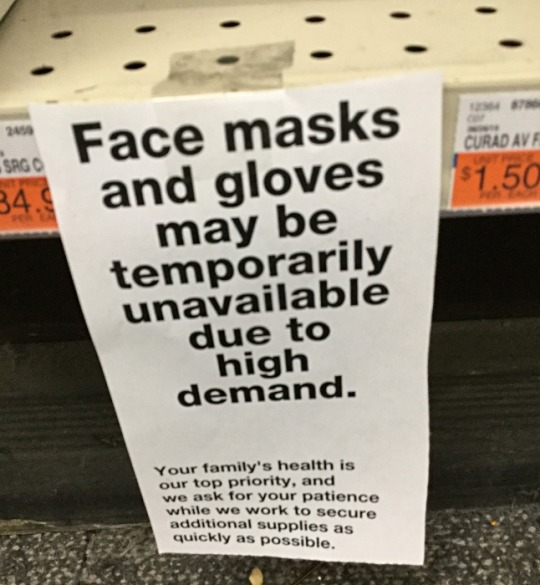
The stock market which Trump in his February tweet claimed looked "very good" was tanking on March 12th – the day before his state of emergency declaration.
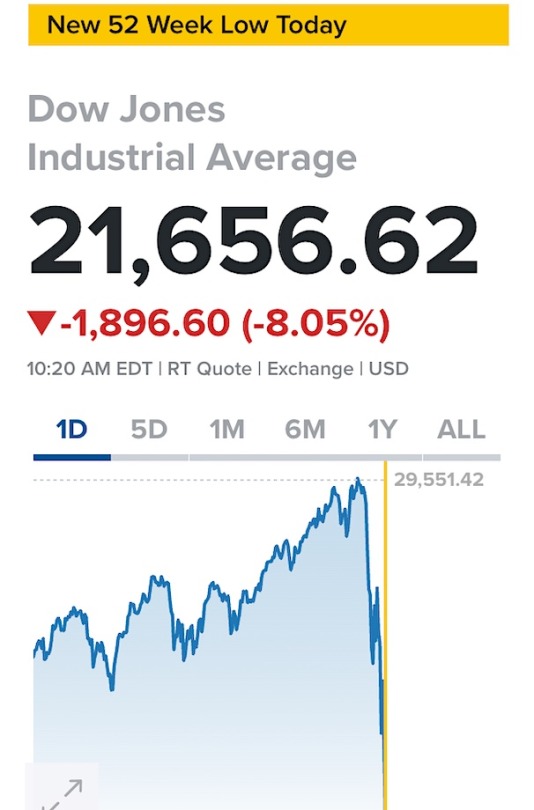
Trump succeeded in sending the US economy into recession much faster than George W. Bush did at the end of his term – quite a feat!. (As an aside, every recession in the US since 1981 has been triggered by Republican presidents.)
Of course Trump never stopped trying to downplay the pandemic nor did he ever take responsibility for it. The US ended up with the highest per capita death rate of any technologically advanced country.
Precious time was lost while Trump dawdled. Orange on this map indicates COVID infections while red indicates COVID deaths. At the time Trump declared a state of emergency, the virus had already spread to 49 states.

The United States could have done far better and it certainly had the tools to do so.
The Obama administration had limited the number of US cases of Ebola to under one dozen during that pandemic in the 2010s. Based on their success, they compiled a guide on how the federal government could limit future pandemics.
Obama team left pandemic playbook for Trump administration, officials confirm
Of course Trump ignored it.
Unlike those boxes of nuclear secrets in Trump's bathroom, the Obama pandemic limitation document is not classified. Anybody can read it – even if Trump didn't. This copy comes from the Stanford University Libraries.
TOWARDS EPIDEMIC PREDICTION: FEDERAL EFFORTS AND OPPORTUNITIES IN OUTBREAK MODELING
Feel free to share this post with anybody who still feels nostalgic about the Trump White House years!
#covid-19#coronavirus#pandemic#public health#donald trump#trump's incompetent response to the pandemic#covid state of emergency#2020#trump recession#51 days of trump pandemic dawdling#obama pandemic playbook#2010s ebola outbreak#nostalgia for trump administration#republicans#election 2024#vote blue no matter who
113 notes
·
View notes
Text
The Congo’s role in creating the bombs dropped on Hiroshima and Nagasaki was kept secret for decades, but the legacy of its involvement is still being felt today.
“The word Shinkolobwe fills me with grief and sorrow,” says Susan Williams, a historian at the UK Institute of Commonwealth Studies. “It’s not a happy word, it’s one I associate with terrible grief and suffering.”
Few people know what, or even where, Shinkolobwe is. But this small mine in the southern province of Katanga, in the Democratic Republic of the Congo (DRC), played a part in one of the most violent and devastating events in history.
More than 7,500 miles away, on 6 August, bells will toll across Hiroshima, Japan, to mark 75 years since the atomic bomb fell on the city. Dignitaries and survivors will gather to remember those who died in the blast and resulting radioactive fallout. Thousands of lanterns carrying messages of peace will be set afloat on the Motoyasu River. Three days later, similar commemorations will be held in Nagasaki.
No such ceremony will take place in the DRC. Yet both nations are inextricably linked by the atomic bomb, the effects of which are still being felt to this day.
The Shinkolobwe mine – named after a kind of boiled apple that would leave a burn if squeezed – was the source for nearly all of the uranium used in the Manhattan Project, culminating with the construction of the atomic bombs dropped on Japan in 1945.
But the story of the mine didn’t end with the bombs. Its contribution to the Little Boy and Fat Man has shaped the DRC’s ruinous political history and civil wars over the decades that followed. Even today the mine’s legacy can still be seen in the health of the communities who live near it.
“It’s an ongoing tragedy,” says Williams, who has examined the role of Shinkolobwe in her book Spies in the Congo. She believes there needs to be greater recognition of how the exploitation and desire to control the mine’s contents by Western powers played a role in the country’s troubles.
Mombilo too is campaigning to raise awareness of the role played by the Congo in deciding the outcome of World War Two, as well as the burden it still carries because of this. In 2016, the CCSSA’s Missing Link forum brought together activists, historians, analysts, and children of those affected by the atomic bomb, both from Japan and from the DR Congo. “We are planning to bring back the history of Shinkolobwe, so we can make the world know,” says Mombilo.
Out of Africa
The story of Shinkolobwe began when a rich seam of uranium was discovered there in 1915, while the Congo was under colonial rule by Belgium. There was little demand for uranium back then: its mineral form is known as pitchblende, from a German phrase describing it as a worthless rock. Instead, the land was mined by the Belgian company Union Minière for its traces of radium, a valuable element that had been recently isolated by Marie and Pierre Curie.
In no other mine could you see a purer concentration of uranium. Nothing like it has ever been found – Tom Zoellner
It was only when nuclear fission was discovered in 1938 that the potential of uranium became apparent. After hearing about the discovery, Albert Einstein immediately wrote to US president Franklin D Roosevelt, advising him that the element could be used to generate a colossal amount of energy – even to construct powerful bombs. In 1942, US military strategists decided to buy as much uranium as they could to pursue what became known as the Manhattan Project. And while mines existed in Colorado and Canada, nowhere in the world had as much uranium as the Congo.
“The geology of Shinkolobwe is described as a freak of nature,” says Tom Zoellner, who visited Shinkolobwe in the course of writing Uranium – War, Energy, and the Rock that Shaped the World. “In no other mine could you see a purer concentration of uranium. Nothing like it has ever been found.”
In a deal with Union Minière – negotiated by the British, who owned a 30% interest in the company – the US secured 1,200 tonnes of Congolese uranium, which was stockpiled on Staten Island, US, and an additional 3,000 tonnes that was stored above ground at the mine in Shinkolobwe. But it was not enough. US Army engineers were dispatched to drain the mine, which had fallen into disuse, and bring it back into production.
Under Belgian rule, Congolese workers toiled day and night in the open pit, sending hundreds of tonnes of uranium ore to the US every month. “Shinkolobwe decided who would be the next leader of the world,” says Mombilo. “Everything started there.”
All of this was carried out under a blanket of secrecy, so as not to alert Axis powers about the existence of the Manhattan Project. Shinkolobwe was erased from maps, and spies sent to the region to sow deliberate disinformation about what was taking place there. Uranium was referred to as “gems”, or simply “raw material”. The word Shinkolobwe was never to be uttered.
This secrecy was maintained long after the end of the war. “Efforts were made to give the message that the uranium came from Canada, as a way of deflecting attention away from the Congo,” says Williams. The effort was so thorough, she says, that the belief the atomic bombs were built with Canadian uranium persists to this day. Although some of the uranium came from Bear Lake in Canada – about 907 tonnes (1,000 tons) are thought to have been supplied by the Eldorado mining company – and a mine in Colorado, the majority came from the Congo. Some of the uranium from the Congo was also refined in Canada before being shipped to the US.
Western powers wanted to ensure that any government presiding over Shinkolobwe remained friendly to their interests
After the war, however, Shinkolobwe emerged as a proxy ground in the Cold War. Improved enrichment techniques made Western powers less dependent on the uranium at Shinkolobwe. But in order to curtail other nations’ nuclear ambitions, the mine had to be controlled. “Even though the US did not need the uranium at Shinkolobwe, it didn’t want the Soviet Union to get access to the mine,” explains Williams.
When the Congo gained independence from Belgium in 1960, the mine was closed and the entrance filled with concrete. But Western powers wanted to ensure that any government presiding over Shinkolobwe remained friendly to their interests.
So important was stopping the Communist threat, says Zoellner, that these powers were willing to help depose the democratically elected government of Patrice Lumumba and install the dictator Mobutu Sese Seko in 1965 for a decades-long reign of ruinous plutocracy.
Attempts by the Congolese people to negotiate better conditions for themselves were attacked as Communist-fuelled sedition. “The idealism, hope, and vision of the Congolese for a Congo free of occupation by an external power was devastated by the military and political interests of the Western powers,” says Williams.
A wound unhealed
Mobutu was eventually toppled in 1997, but the spectre of Shinkolobwe continues to haunt the DRC. Drawn by rich deposits of copper and cobalt, Congolese miners began digging informally at the site, working around the sealed mineshafts. By the end of the century, an estimated 15,000 miners and their families were present at Shinkolobwe, operating clandestine pits with no protection against the radioactive ore.
Accidents were commonplace: in 2004, eight miners were killed and more than a dozen injured when a passage collapsed. Fears that uranium was being smuggled from the site to terrorist groups or hostile states vexed Western nations, leading the Congolese army to raze the miners’ village that same year.
Stories abound of children born in the area with physical deformations, but few if any medical records are kept
Despite the mineral wealth present at Shinkolobwe, since Union Minière withdrew in the early 1960s there has never been an industrial mine that could safely and efficiently extract the ores and return the proceeds to the Congolese people. After the Fukushima nuclear accident in 2011, any interest in extracting the uranium for civilian use withered away. “Uranium, even in its natural condition, resists control,” says Zoellner. “Right now Shinkolobwe exists in a limbo, a symbol for the inherent geopolitical instability of uranium.”
The ongoing secrecy around Shinkolobwe (many official US, British and Belgian records on the subject are still classified) has stymied efforts to recognise the Congolese contribution to the Allied victory, as well as hampering investigation into the environmental and health impacts of the mine.
“The effects are medical, political, economic, so many things,” says Mombilo. “We’re not able to know the negative effects of radiation because of this secrecy.” Stories abound of children born in the area with physical deformations, but few if any medical records are kept. “I had a witness who died with his brain coming out of his head, because of the radiation,” says Mombilo. “In all these years, there is not even a special hospital, there is no scientific study or treatment.”
Many of those affected by Shinkolobwe are now campaigning for recognition and reparation, but knowing who should receive them – and who should pay – is compounded by the lack of information made available about the mine and what took place there.
“Shinkolobwe is a curse on the Congo,” says Mombilo.
But he adds that for over a century, the country’s rich resources have made possible one global revolution after another: rubber for tyres made automobiles possible, uranium fuelled nuclear reactors, coltan built the computers of the information age, and cobalt powers the batteries of mobile phones and electric vehicles.
“Our world is moved by the minerals of the Congo,” says Mombilo. “The positive thing I can say is that in all these advanced technologies, you’re talking about the Congo.”
The Congo’s impact on the world has been immeasurable. Recognising the name Shinkolobwe alongside Hiroshima and Nagasaki should be the first step to repaying that debt. {read}
#article#BBC#history#war crimes#atomic bomb#congo#world war 2#world war ii#colonialism#colonization#us imperialism#mining#Hiroshima
15 notes
·
View notes
Text
The Brazilian president, Luiz Inácio Lula da Silva, has told developed countries to put their money where their mouth is when it comes to protecting the world’s remaining tropical forests, as major rainforest nations demanded hundreds of billions of dollars of climate financing and a greater role in how those resources are spent. “It’s not Brazil that needs money. It’s not Colombia that needs money. It’s not Venezuela. It’s nature,” Lula told journalists on the second day of a major environmental summit in the Amazon city of Belém. For two centuries, industrialized nations filled the world’s atmosphere with pollution, Lula declared, “and they now need to pay their bit to restore part of that which was wrecked”. ... Lula’s appeal came after hours of meetings between the leaders of the Amazon’s eight nations and representatives of fellow rainforest nations, the Republic of the Congo, the Democratic Republic of Congo (DRC) and Indonesia. ... Lula said the fledgling rainforest bloc had a simple message to those “rich countries” in the lead up to November’s Cop28 summit in Dubai: “If they want to effectively preserve what is left of the forests, they must spend money – not just to take care of the canopy of the trees but to take care of the people who live beneath that canopy and who want to work, to study and to eat and … to live decently.”
62 notes
·
View notes
Text
David Zipper at Vox:
Despite a recent slowdown in US sales, global forecasts for electric vehicles remain bullish. Countries across North America, Europe, and Asia are expanding charger networks and offering EV subsidies; global EV sales are projected to nearly triple by 2030, reaching 40 million vehicles annually. The incipient wave of EV purchases raises a question: What will happen to the millions of gas-powered cars whose owners no longer want them? The likely answer: Rather than scrapping used gas vehicles or selling them domestically, rich nations will dispatch them to developing countries where limited incomes and low levels of car ownership have created eager buyers for even older, substandard models.
An influx of used gas cars would be a welcome development for those in the Global South who aspire to automobile ownership, a luxury that many in affluent countries take for granted. But it would undermine efforts to mitigate climate change, since shifting gas guzzlers from one country to another doesn’t lower global emissions. For developing countries themselves, a sharp increase in car ownership could amplify calls to build auto-reliant infrastructure, making it harder to construct the dense neighborhoods and transit networks that can foster more sustainable growth. And since these imported used cars would be fueled by gasoline, air quality would further decline in cities that are already choked with smog. The world is in an era of polycrisis, facing concurrent challenges including climate change, toxic air, and extreme inequality. Difficult trade-offs are often inevitable. Such is the case with the thorny issue of what to do with the millions of gas cars that the rich world will discard as its fleets are electrified. Electrification is a necessary goal. And it’s natural for people in the developing world to desire the same luxuries that characterize middle-class comfort in wealthier countries. The question is how to manage a transition with enormous stakes that has largely been ignored. The experts who do pay attention are growing alarmed.
[...]
How used cars move from rich nations to poor ones
Although it generates few headlines, a massive industry transports used cars across borders every day, with exporters collecting lower-quality models from dealers and wholesale auctions. Ayetor noted that colonial legacies are reflected in the trade flows: the UK, with its car cabins designed for drivers who keep to the left, tends to ship to former colonies like Kenya and Tanzania that still follow the same rules.
According to a report issued in June by the United Nations Environment Programme (UNEP), some 3.1 million used cars were exported in 2022, up from 2.4 million in 2015. Most come from Japan, Europe, and the United States. (In the US, around 7 percent of all cars no longer in use are sent abroad. The rest end up in junkyards where their parts and materiel are sold off.) About one in three exported used vehicles is destined for Africa, followed by Eastern Europe, Asia, the Middle East, and Latin America. Imported models often dominate local auto sales, since international carmakers send few new vehicles to the Global South and rarely establish production facilities there. (In sub-Saharan Africa, only South Africa has local factories.) The developing world’s demand for cars is robust, in large part because comparatively few people own one. According to one 2020 estimate, the US had 860 cars for every 1,000 residents, while South Africa had 176, Morocco 112, and Nigeria just 56. Meanwhile, growing populations provide a steady supply of new potential customers. Africa is home to all of the world’s 20 fastest-growing countries, with Angola, Democratic Republic of the Congo, Niger, and Uganda expanding their populations by at least 3 percent per year. (For comparison, the US population is growing at a 0.67 percent rate).
[...]
The world needs a plan to adapt
The risks of aged, polluting cars sent abroad will not be borne by the Global South alone. Climate change is a planetary phenomenon; driving a gas guzzler produces the same amount of emissions in Lusaka as it would in London or Los Angeles. Reducing greenhouse gasses requires reducing total vehicle emissions, not just shifting their location. In an ideal world, electrification would enable the rich world to scrap its most decrepit gas cars. Instead, wealthy nations are likely to ship them to poorer countries, which will be left to figure out what to do when even the most MacGyver-like mechanics cannot keep them running. “All of your worst vehicles end up here,” Ayetor said. “When we want to get rid of the vehicle, what do we do?” No wealthy nations currently screen exported vehicles to weed out those that flunk basic quality tests, Kopf said. But that may soon change. The European Union is now considering new regulations that would prohibit exporting “end of life” vehicles, requiring that cars shipped abroad obtain a certificate confirming their roadworthiness. Its adoption would be a “game-changer,” according to UNEP’s Akumu. (She and Kopf said they know of no comparable proposals under consideration in North America.)
With the increase of electric vehicles in the developed countries, used gas-fueled cars are headed to a developing country (aka the Global South) at increasing rates.
5 notes
·
View notes
Text
The creation of the "Alliance Fleuve Congo" was made official on Friday in Nairobi, the Kenyan capital. At the helm is Corneille Nangaa, the former chairman of the Electoral Commission.
In a video posted on social networks, he openly allied himself with several rebel movements, including the M23, which took up arms against the government in November 2021.
The movement, which is active in the east of the DRC and, according to sources, supported by Rwanda, was represented in Nairobi by its president Bertrand Bisimwa.
Corneille Nangaa has announced that his platform currently comprises 17 political parties, two political groupings and several armed groups.
A close associate of former president Joseph Kabila, he is calling on armed groups scouring swathes of the DRC to join his movement.
According to its founder, the aim of the "Alliance Fleuve Congo" is to save the DRC, which has been in a state of chronic instability for three decades, mainly due to the weakness and absence of the state, to re-establish its sovereignty and put an end to insecurity.[...]
Corneille Nangaa also thanked the Kenyan authorities for their hospitality. Nairobi, whose soldiers involved in the East African force recently left the DRC [is alleged to collude] with rebel groups, including the M23.
15 Dec 23
[PulseLive is Private Kenyan Media]
"The Ministry of Foreign & Diaspora Affairs of the Republic of Kenya refers to press reports that some nationals of the Democratic Republic of Congo claiming association with rebel groups within DRC addressed a press conference in Nairobi and made statements that are prima facie inimical to the constitutional order of the Democratic Republic of Congo," Mudavadi stated.
"The Ministry wishes to note that Kenya is an open and democratic state where freedom of the press is vouchsafed. As such, nationals and non-nationals may engage the Kenyan media without reference to the government.
"Kenya strongly disassociates itself from any utterances or activities likely to injure the peace and security of the friendly Nation of DRC and has commenced investigation to determine the identities of the makers of the statement and the extent to which their utterances fall outside constitutionally protected speech. Kenya further affirms its non-involvement in the internal affairs of DRC and commits to continue supporting the peace, security, and democratic consolidation of the country." Mudavadi added in the statement.
17 Dec 23
[BBC is UK State Media]
[Machine Translation]
Corneille Nangaa of the Alliance Fleuve Congo released the first announcement that he is in Rutshuru
The head of the political and military coalition that opposes the government of Kinshasa recently formed in Nairobi, Kenya, issued his first statement signed from Rutshuru in the province of North Kivu, asking the public to reconcile and remove "urgently" President Felix Tshisekedi.
In a statement presented by M23's Bertrand Bisimwa , Corneille Nanga, who headed the electoral commission of DR Congo in the 2018 presidential election that gave victory to Tshisekedi, condemned the latest election.
This month, on the last day of the campaign, President Tshisekedi said that this conference of Corneille Nangaa in collaboration with the M23 movement was a "Nairobi joke" organized by Rwanda.
He said: “If they provoke us even a little, very little, I will gather both houses of the Legislative Assembly and ask for permission to declare war on Rwanda.
He added: "...don't be afraid, today our army can shoot in Kigali in Goma... Kagame [the president] will not sleep in his house, he will sleep in the forest, playing with other people and not playing with Fatshi Beton (Felix Tshisekedi)."
29 Dec 23
16 notes
·
View notes
Text
How you can help Palestine 🇵🇸
I have compiled every helpful post I’ve seen on Palestine under this tag (this link is also in my pinned post) -> #posts to help Palestine
Here is a masterpost listing what you can do that are specific to where you live, as well as many other resources - always reblog and check the original post because OP updates it regularly -> here
If you cannot donate money, click here every day to donate to UNRWA (United Nations Relief and Works Agency for Palestinian Refugees) -> here
Learn what esims Gaza needs right now and how to donate esims -> here
This is a masterlist with many resources to help Palestine, Sudan, and Democratic Republic of the Congo -> here
For news and updates, Al Jazeera is a reliable source -> here
If you have any suggestions of more resources please reblog and add if you like!
#palestine#free palestine#gaza#free gaza#israel#jerusalem#west bank#justice for palestinians#justice for palestine
21 notes
·
View notes
Text

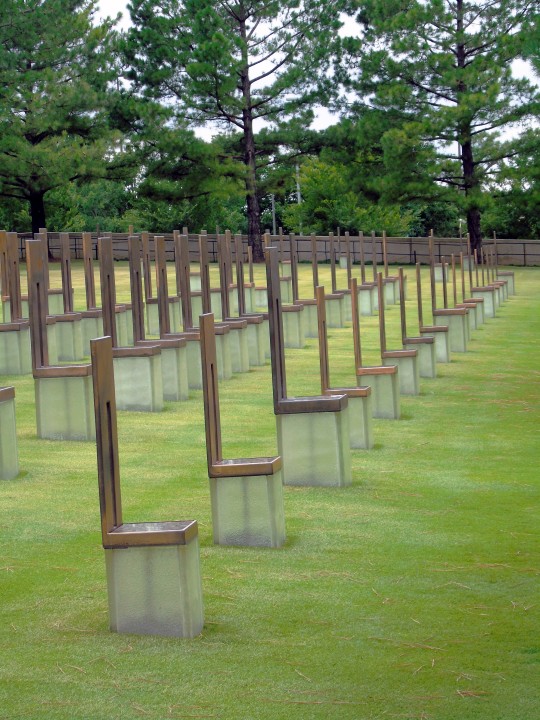






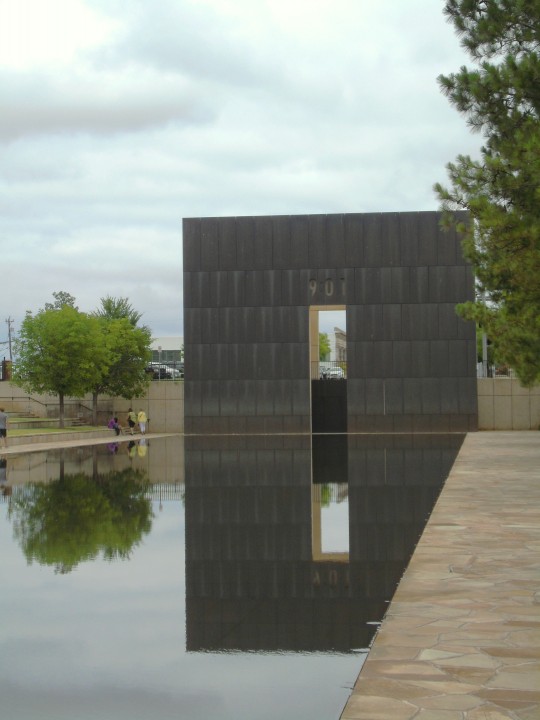
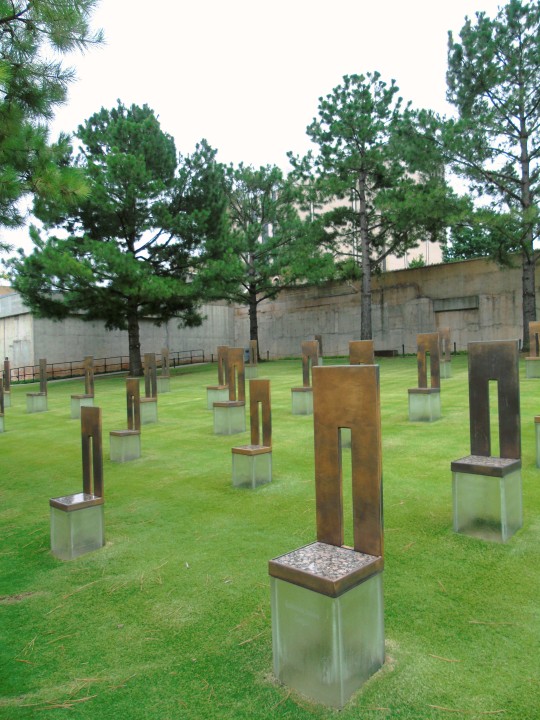

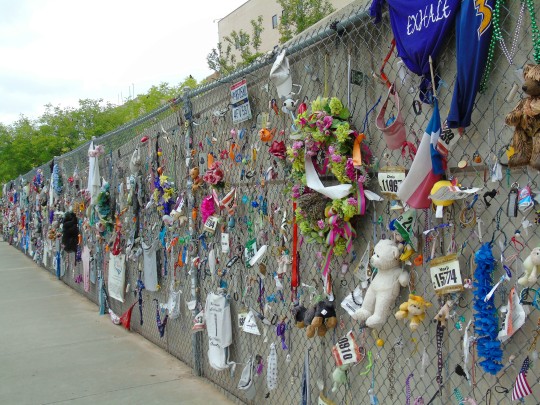
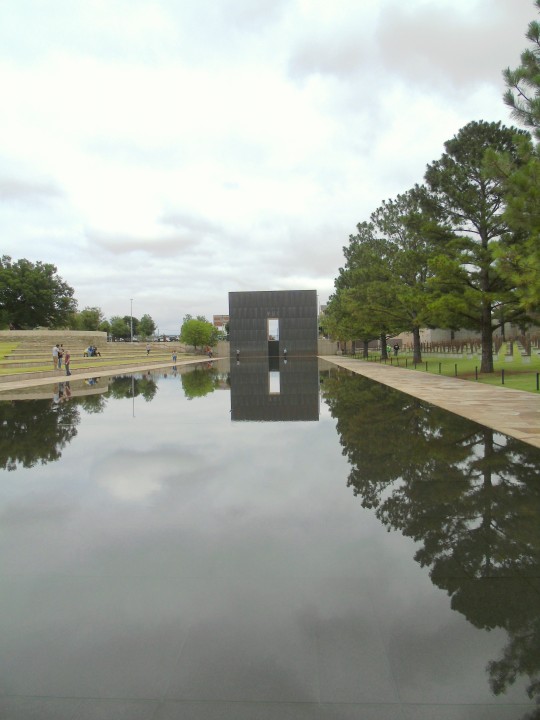




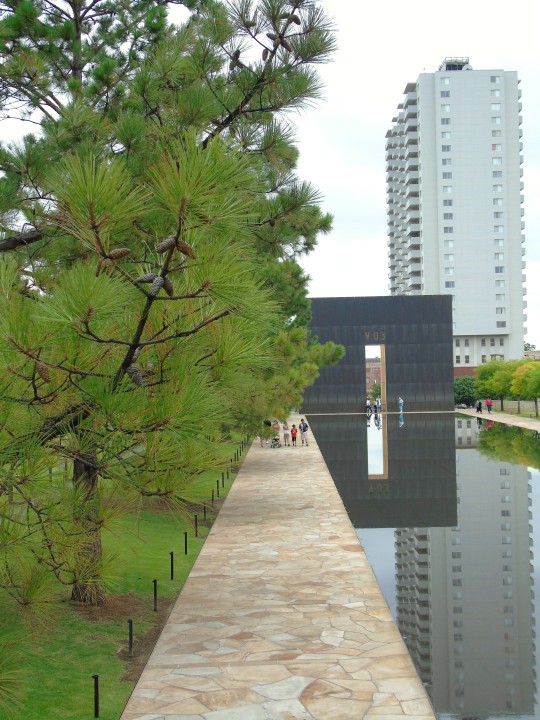

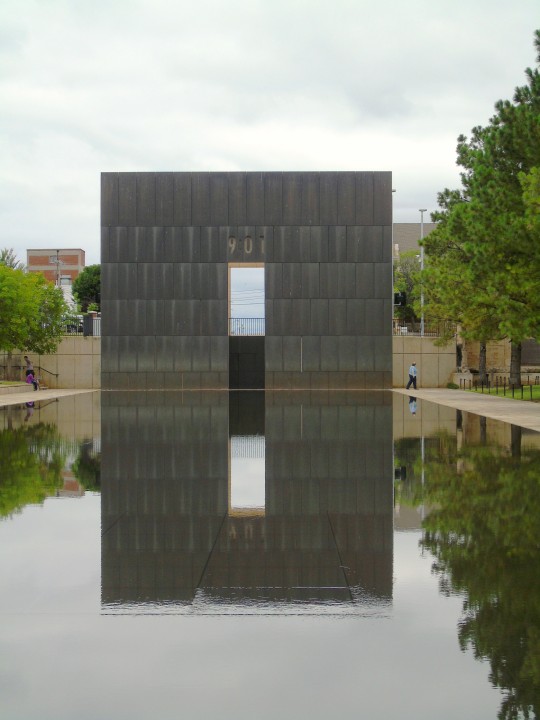
National Oklahoma City Bombing Commemoration Day
National Oklahoma City Bombing Commemoration Day is celebrated on April 19 annually. This day aims at honoring the deceased, injured, and volunteers when the devastating event occurred. Two anti-government extremists — Timothy McVeigh and Terry Nichols perpetrated the terrorist attack. They did this with white supremacists and right-wing terrorist sympathies. The bombing happened at 9:02 a.m. at the Alfred P. Murrah Federal Building in Oklahoma City, Oklahoma, and killed at least 168 people, injured more than 680 others, and destroyed more than one-third of the building.
History of National Oklahoma City Bombing Commemoration Day
Timothy McVeigh, an ex-Army soldier and security guard, parked a rented Ryder truck in front of the Alfred P. Murrah Federal Building in downtown Oklahoma City on April 19, 1995. He decided to commit mass murder there. The bomb was a powerful one. It consisted of a deadly cocktail of agricultural fertilizer, diesel fuel, and other chemicals. McVeigh got out of the rented car with the bomb inside, locked the door, and headed towards his getaway car. He ignited one timed fuse, then another. At 9:02 a.m., the bomb exploded.
A third of the building had been reduced to rubble in just a few seconds, with many floors flattened. The surrounding area looked devastated. More than 300 nearby buildings were damaged or destroyed; dozens of cars were incinerated. The consequences to human beings were still more devastating: 168 souls were lost, including 19 children, with several hundred more injured.
It was the worst act of terrorism in United States history. The F.B.I. quickly arrived at the scene to support rescue efforts and investigate the facts. There were clues in the area they found. On April 20, thanks to the rear axle of the Ryder truck, the vehicle identification number was traced to a body shop in Junction City, Kansas. Employees helped the F.B.I. quickly compose a composite drawing of the man who had rented the van. F.B.I. agents started to show the sketch around town, and local hotel employees supplied a name: Tim McVeigh.
National Oklahoma City Bombing Commemoration Day timeline
1995The Bombing Occurs
On April 19, 1995, the Alfred P. Murrah Federal Building in downtown Oklahoma City is destroyed by a terrorist attack.
1997Terrorists are Tried
The bombers are tried and convicted.
2001McVeigh is Executed
McVeigh is sentenced to death, and executed by lethal injection.
2003Alfred P. Murrah Federal Building is Replaced
The Alfred P. Murrah Federal Building is replaced with a 185,000-square-foot building.
National Oklahoma City Bombing Commemoration Day FAQs
What components' symbols are used in the Oklahoma City Memorial?
There are nine rows, each representing a floor of the federal building where the field is now located. Each chair has the name of someone killed, and smaller chairs stand for the children.
How old was Timothy McVeigh when he was executed?
He was 33 years old.
Why is it difficult for the United Nations to draft a definition of terrorism?
Mainly because the characteristics of terrorism are hard to define. Many member countries harbor terrorists.
How to Observe National Oklahoma City Bombing Commemoration Day
168 seconds of silence
Information
Post on social media
168 people died in the bombings. The nation joins 168 seconds of silence to honor those people.
Learn about terrorist attacks and bombings. Learn how Oklahoma City recovered from this devastating event.
Write a post on social media to raise awareness about this commemoration day. Do not forget to use the hashtag #OklahomaCityBombingCommemorationDay.
5 Terrorist Attacks In History
AMIA bombing
U.S. Embassy Bombings
September 11 attacks
Christmas massacres
7/7 bombings
It occurred in 1994 in Buenos Aires, Argentina.
It occurred in 1998 in Kenya and Tanzania.
It occurred in 2001 in New York, United States.
It occurred in 2008 in the Democratic Republic of Congo.
These occurred in London, killing 56.
Why National Oklahoma City Bombing Commemoration Day is Important
It is a day to remember
It is a day to raise awareness
It is an opportunity to address threats of violence
This day is perfect for remembering those who died not only in the Oklahoma Bombing but also in any other terrorist attacks. Many people die in this type of attack.
This day is also helpful in raising awareness about the problem of terrorism. Security issues affect almost all countries.
Awareness is crucial to disrupting terrorist plots to avoid future attacks. Governments should be committed to holding accountable those who perpetrate such attacks.
Source
#National Oklahoma City Bombing Commemoration Day#19 April 1995#USA#Oklahoma City#Oklahoma#anniversary#US history#white terrorism#travel#summer 2014#South Central Region#original photography#tourist attraction#landmark#reflecting pool#cityscape#Oklahoma City National Memorial#OklahomaCityBombingCommemorationDay#Field of Empty Chairs#Survivor Tree#Gate of Time#Survivors' Wall#architecture#vacation
6 notes
·
View notes
Text
Holidays 8.1
Holidays
African Emancipation Day (Trinidad and Tobago)
Air Force Day
Armed Forces Day (China, Lebanon)
Azerbaijani Language and Alphabet Day
Basil Day (French Republic)
Battle of Athens Day
Bitcoin Independence Day
Caribbean Day
Chopsticks Day
Clergy Sexual Abuse Awareness and Prevention Day
Cross-Quarter Day
Cycle to Work Day (UK)
Day of Azerbaijani Language and Alphabet
Day of Pachamama (Peru)
Day of the Rear Services of the Armed Forces (Russia)
Day of the Telephone Operator (Mexico)
DOGust
Earth Overshoot Day 2024 (a.k.a. Ecological Debt Day) [ website ]
Ectopic Pregnancy Awareness Day
801 Day
Emancipation Day (UK; British Commonwealth)
Freedom Day (Belize)
Freedom to Marry Day (Minnesota)
Friendship Day
Gold Star Children’s Day
Girlfriends’ Day
Good Sportsmanship Day
Grain Marketing Freedom Day (Canada)
Guca Brass Bands Day (Serbia)
Harriet Quimby Day
HitchBOT Remembrance Day
Homowo (a.k.a. Hooting at Hunger; Ghana)
Indigenous Peoples Day (Taiwan)
International Adaptive Activity Day
International Can-It-Forward Day
International Childfree Day
International Mahjong Day
International Marine Protected Areas Day
International Sri Lankan Leopard Day
International Woo-Ah Day
Jerry Day
Laa Luanys (Isle of Man)
Laughter Day (Southern California)
Led Zeppelin Day
Liberation of Haile Selassie Day (Rastafari)
Memorial Day for the Victims of World War I (Russia)
Minden Day (UK)
Minority Donor Awareness Day
MTV Day
National Alpaca Day (Peru)
National American Family Day
National Andrew Day
National CBD Day
National Girlfriends Day
National Huddle Ledbetter Day
National Mahjong Day
National Minority Donor Awareness Day
National Mountain Climbing Day
National Non-Parent Day
National Poll Worker Recruitment Day
National Promise to Care Day
National Spritz Day
National Waifu Day
National Warsaw Uprising Remembrance Day (Poland)
National Wedding Day (UK)
National York Day
Odaiba Day
Oxygen Discovery Day
Parents’ Day (Democratic Republic of the Congo; Zaire)
Planner Day
Play Ball Day
Pod Body Day (Portland, Maine)
Respect For Parents Day
RNA Day
Rounds Resounding Day
San Francisco Cable Car Day
Scout Foundation Day
Scout Scarf Day
Social Resistance Day (North Cyprus)
Spider-Man Day
Sports Day
SSN 801 Day
Startup Day Across America
Swiss National Day
Technical Support Worker Day (Russia)
Treida de Santo Domingo de Guzmán (Nicaragua)
Thoroughbred Birthday (Southern Hemisphere)
Victory Day (Cambodia, Laos, Vietnam)
White Rabbit Day
Wipe the Slate Clean Day
Woman Astronomers Day
Women’s Day (Thailand)
World Breastfeeding Day
World Day of Joy
World Fintech Day
World Lung Cancer Day
World Middle Finger Day
World Naked Sailing Day
World Scout Scarf Day
World Wide Web Day
Yaoi Day
Yorkshire Day (England)
Food & Drink Celebrations
Belgian Frites Day (a.k.a. International Day of Belgian Fries)
Homemade Pie Day
International Albariño Day
International Can-It Forward Day
Mars Bar Day
National Nutritional Yeast Day
National Raspberry Cream Pie Day
Old Vine Day
Independence & Related Days
Benin (originally Dahomey; from France, 1960)
Colorado Statehood Day (#38; 1876)
Guadalcanal Province Day (Solomon Islands)
Jennytopia (Declared; 2019) [unrecognized]
Switzerland (a.k.a. Confederation Day; from Holy Roman Empire, 1291)
Toku (Declared; 2014) [unrecognized]
Vodopol (Declared; 2021) [unrecognized]
1st Thursday in August
August Thursday (Anguilla) [1st Thursday]
Emancipation Day (Bermuda; 1st Day of Cup Match) [Thursday before 1st Monday in August]
Kid Lit Art Postcard Day [1st Thursday]
National Dash Cam Day (UK) [1st Thursday]
National IPA Day (f.k.a. International IPA Day) [1st Thursday]
Weekly Holidays beginning August 1 (1st Week of August)
Brat Days (Sheboygan, Wisconsin) [1st Thursday thru Sunday]
Carnaval del Pueblo (London, UK) [1st Week]
International Assistance Dog Week (thru 8.7) [1st Week]
International Clown Week (thru 8.7)
International Mathematicians Week (thru 8.9)
National Albariño Week (thru 8.5)
National Cleanse Your Skin Week (thru 8.7)
National Fraud Awareness Week (thru 8.7) [1st Week]
National Minority Donor Awareness Week (thru 8.7)
National Scrabble Week (thru 8.7) [1st Week]
National Video Game Week (thru 8.7) [1st Week]
Satchmo Days [begin Thursday nearest 8.4 thru Sunday]
Simplify Your Life Week (thru 8.7)
World Breastfeeding Week (thru 8.7) [1st Week]
Festivals Beginning August 1, 2024
American Cured Meat Championships (Omaha, Nebraska) [thru 8.3]
August is Maine Lobster Month (Statewide, Maine) [thru 8.31]
Bear Lake Raspberry Days Festival (Garden City, Utah) [thru 8.3]
Castlefest (Lisse, Netherlands) [thru 8.4]
Clam Festival (Highlands, New Jersey) [thru 8.3]
Denver Burger Battle (Denver, Colorado)
Eden Corn Festival (Eden, New York) [thru 8.4]
Empire Farm Days (Pompey, New York) [thru 8.3]
Estherville Sweet Corn Days (Estherville, Iowa) [thru 8.4]
Gen Con (Indianapolis, Indiana) [thru 8.4]
Green Gathering (Chepstow, United Kingdom) [thru 8.4]
Houston Restaurant Weeks (Houston, Texas) [thru 9.2]
Katahdin Sheep Show (Mexico, Missouri) [thru 8.3]
Klamath County Fair (Klamath Falls, Oregon) [thru 8.4]
Lollapalooza (Chicago, Illinois) [thru 8.4]
Mammoth Festival of Beers & Bluesapalooza (Mammoth Lakes, California) [thru 8.4]
Mile of Music (Appleton, Wisconsin) [thru 8.4]
Minnesota Fringe Festival (Minneapolis, Minnesota) [thru 8.11]
Mobile Motion Film Festival (Zurich, Swizterland) [thru 8.31]
Official Star Trek Convention (Las Vegas, Nevada) [thru 8.4]
Outer Banks Watermelon Festival (Nag's Head, North Carolina)
Owensville Watermelon Festival (Owensville, Indiana) [thru 8.3]
Phelps Sauerkraut Weekend (Phelps, New York) [thru 8.4
Pol’and’Rock Festival (Woodstock Festival Poland; Czaplinek, Poland) [thru 8.3]
Saint Dominic Days (Managua) [thru 8.10]
Saskatoon Fringe Festival (Saskatoon, Canada) [thru 8.10]
Spicemas (Grenada Carnival; St. George’s, Grenada) [thru 8.13]
Sumner County Fair (Caldwell, Kansas) [thru 8.4]
Toronto Caribbean Carnival (Toronto, Canada) [thru 8.5]
Twin Cities Vegan Chef Challenge (Minneapolis, Minnesota) [thru 8.31]
Washington Wine Month (Washington State) [thru 8.31]
Wisconsin State Fair (West Allis, Wisconsin) [thru 8.11]
World Lumberjack Championships [thru 8.3]
XIT Rodeo & Reunion (Dalhart, Texas) [thru 8.3]
Zanzibar International Film Festival (Zanzibar City, Tanzania) [thru 8.4]
Feast Days
Abgar V of Edessa (Syrian Church)
Alan Moore (Australian War Artist; Artology)
Aled (a.k.a. Eiluned or Almedha; Christian; Martyr & Virgin)
Alphonsus Maria de' Liguori (Christian; Saint)
Æthelwold of Winchester (Christian; Saint)
Bernard Võ Văn Duệ (Christian; One of Vietnamese Martyrs)
Betty Lou’s Dad (Muppetism)
Cartoon Day (Pastafarian)
Chantal Montellier (Artology)
David Gemmell (Writerism)
Day of the Dryads (Macedonia)
Dormition Fast (Orthodox Church) [thru 8.14]
Drug Side-Effects Day (Church of the SubGenius)
Ethelwold of Winchester (Christian; Saint)
Eusebius of Vercelli (Christian; Saint)
Exuperius of Bayeux (Christian; Saint)
Faith, Hope, and Charity (Christian; Virgin Martyrs)
Feast of Faith, Hope, Charity, and their Mother, Wisdom (Christian; Martyrs)
Feast of Kamál (Perfection; Baha'i)
Feast of Ninlil (Sumerian Goddess of the Grain)
Felix of Girona (Christian; Saint)
Festival of Lugh (Celtic here god)
Festival of Xiuhtechuhtli (Aztec God of the Calendar)
Gerhard Hirschfelder (Christian; Blessed)
Herman Melville (Writerism)
The Holy Maccabees (Christian; Saint)
Imps Charity Scramble (Shamanism)
Isobel Lilian Gloag (Artology)
Jackie Ormes (Artology)
James Henry Govier (Artology)
Jan van Scorel (Artology)
Kalends of August (Ancient Rome)
Lammas (a.k.a. ...
Feast of Bread (Neopagan)
Feast of First Fruits (England, Scotland)
Feast of the Wheat Harvest
Festival of Albina (Irish White Barley Goddess; aka Alphito)
Festival of the First Fruits
Gule of August (England, Scotland)
Imbolc (So. Hemisphere; Neopagan)
Lady Day Eve (Neopagan)
Lammas, Day 2 (Celtic, Pagan) [5 of 8 Festivals of the Natural Year]
Lammas Eve (a.k.a. Lughnassad Eve)
Lammas Sabbat
Luanistyn (Manx Gaelic)
Lithasblot (Norse Harvest Festival)
Loaf Mass
Loki and Sigyn’s Day (Norse)
Lugh (Celtic Book of Days)
Lughnasa
Lughnasadh (Grain Harvest) [Ends on Samhain]
Lúnasa (Modern Irish)
Lùnastal (Scottish Gaelic)
Sexon Hlafmaesse
Lobster Boy Day (Church of the SubGenius; Saint)
Mati-Syra-Zemlya Day (Slavic Goddess of the Earth)
Pachamama Rayni (Festival Celebrating Mother Earth) [Ecuador; Peru]
Pellegrini (a.k.a. Peregrinus), Hermit (Christian; Saint)
Peter Apostle in Chains (Christian; Saint)
Procession of the Cross and the beginning of Dormition Fast (Eastern Orthodox)
Quarter Day (Scotland)
Richard Wilson (Artology)
Rose Macaulay (Writerism)
Sebastiano Ricci (Artology)
The Spanish Romancers (Positivist; Saints)
Vhrsti (Artology)
Warsan Shire (Writerism)
Lucky & Unlucky Days
Dismal Day (Unlucky or Evil Day; Medieval Europe; 15 of 24)
Egyptian Day (Unlucky Day; Middle Ages Europe) [15 of 24]
Fatal Day (Pagan) [15 of 24]
Tomobiki (友引 Japan) [Good luck all day, except at noon.]
Unlucky Day (Grafton’s Manual of 1565) [35 of 60]
Unlucky Monday (when Eve gave birth to Cain; Philippines) [1st Monday] (3 of 4)
Premieres
Alfred, by Thomas Arne (Opera; 1740)
Alice the Peacemaker (Disney Cartoon; 1924)
American Graffiti (Film; 1973)
Bargain Daze (Heckle & Jeckle Cartoon; 1953)
Being and Time, by Martin Heidegger (Book; 1927)
Big Chief No Treaty (Terrytoons Cartoon; 1962)
The Big Money, by John Dos Passos (Novel; 1936)
Burning Love, by Elvis Presley (Song; 1972)
Cape Kidnaveral (Noveltoons Cartoon; 1961)
Charley’s Aunt (Film; 1941)
Cook and Stagger (Terrytoons Cartoon; 1956)
Cloudy with a Chance of Meatballs, by Judi and Ron Barrett (Children’s Book; 1978)
Concert for Bangladesh, hosted by George Harrison (Charity Concert; 1971)
Cosi Fan Tutti Frutti, by Squeeze (Album; 1985)
Cowardly Watchdog (Terrytoons Cartoon; 1966)
Crazy with the Heat (Disney Cartoon; 1947)
Crusader Rabbit (Jay Ward Cartoon TV Series; 1950)
The Dog Show (Terrytoons Cartoon; 1950)
Driven to Extraction (Terrytoons Cartoon; 1963)
Dune, by Frank Herbert (Novel; 1965)
The Dusters, featuring the Mighty Heroes (Terrytoons Cartoon; 1971)
The Electric Kool-Aid Acid Test, by Tom Wolfe (Novel; 1968)
Eric, by Terry Pratchet (Novel; 1990) [Discworld #9]
Everybody’s Rockin’, by Neil Young (Album; 1983)
The Fabulous Firework Family (Terrytoons Cartoon; 1959)
The Final Countdown (Film; 1980)
Flebus (Terrytoons Cartoon; 1957)
Flight of the Navigator (Film; 1986)
The Four Musicians of Bremen (b Iwerks Cartoon; 1922)
A Game of Thrones, by George R.R. Martin (Novel; 2000) [A Song of Fire and Ice #1]
Gangsta’s Paradise, by Coolio (Song; 1995)
Generals and Majors, by XTC (Song; 1980)
The Genie with the Light Touch (Woody Woodpecker Cartoon; 1972)
The Girl with the Dragon Tattoo, by Stieg Larsson (Novel; 2008) [Millennium Trilogy #1]
Give Me Liberty (Terrytoons Cartoon; 1967)
Golden Egg Goose (Terrytoons Cartoon; 1951)
Guardians of the Galaxy (Film; 2014)
Heaven Can Wait (Film; 1943)
The Highwayman, by Alfred Noyes (Poem; 1906)
The Hound of the Baskervilles, by Arthur Conan Doyle (Novel; 1901)
House Busters (Heckle & Jeckle Cartoon; 1952)
Howard the Duck (Film; 1986)
How to Catch a Cold (Disney Cartoon; 1951)
Jeremy, by Pearl Jam (Music Video; 1992)
Judo Kudos (Terrytoons Cartoon; 1968)
King Tut’s Tomb (Heckle & Jeckle Cartoon; 1950)
The Littlest Bully (Terrytoons Cartoon; 1960)
The Lyin’ Lion (Terrytoons Cartoon; 1949)
Make Way for Ducklings, by Robert McCloskey (Children’s Book; 1941)
Meat, Drink and Be Merry (Terrytoons Cartoon; 1961)
Modern Man in Search of a Soul, by C.G. Jung (Philosophical Book; 1933)
Money (That’s What I Want), by Barrett Strong (Song; 1959)
The Monkey Wrench Gang, by Edward Abbey (Novel; 1975)
Mrs. Jones’ Rest Farm (Terrytoons Cartoon; 1949)
MTV (Cable Network; 1981)
MySpace (Social Media App; 2003)
96 Tears, by ? and the Mysterians (Song; 1966)
North Dallas Forty (Film; 1979)
Nothing in Common (Film; 1986)
Oil Through the Day (Terrytoons Cartoon; 1964)
Open House (Terrytoons Cartoon; 1953)
Paul Bunyan (Disney Cartoon; 1958)
Porky the Rain-Maker (WB LT Cartoon; 1936)
Pride of the Yard (Terrytoons Cartoon; 1954)
Rain Dogs, by Tom Waits (Album; 1985)
Rear Window (Film; 1954)
Rebecca, by Daphne du Maurier (novel; 1938)
The Road Not Taken (Poem; 1925)
Robots in Toyland (Terrytoons Cartoon; 1965)
Rule Britannia, by Thomas Arne (Song; 1740)
Señorella and the Glass Huarache (WB LT Cartoon; 1964)
Shadows on the Rock, by Willa Cather (Novel; 1931)
Shootin’ Stars (Modern Madcaps Cartoon; 1960)
Shotgun Shambles (Terrytoons Cartoon; 1962)
Sick, Sick Sidney (Terrytoons Cartoon; 1958)
The Snows of Kilimanjaro, by Ernest Hemingway (Short Story; 1936)
Steel Wheels, by The Rolling Stones (Album; 1989)
Superiority, by Arthur C. Clarke (Short Story; 1951)
A Swiss Miss (Mighty Mouse Cartoon; 1950)
The 39 Steps (Film; 1935)
Tot Watchers (Tom & Jerry Cartoon; 1958)
Trouble in Baghdad (Terrytoons Cartoon; 1963)
Truant Officer Donald (Disney Cartoon; 1941)
The Trumpet of the Swan, by E.B. White (Children’s Book; 1970)
Turning the Fables (Noveltoons Cartoon; 1960)
The Twist, by Chubby Checker (Song; 1960)
Video Killed the Radio Star, by The Buggles (Music Video; 1981)
A Wedding Knight (Modern Madcaps Cartoon; 1966)
The Wiggles, by The Wiggles (Album; 1991)
Wild and Woolly Hare (WB LT Cartoon; 1959)
Witchy Woman, by The Eagles (Song; 1972)
Today’s Name Days
Alfons, Kenneth, Peter (Austria)
Alfonz, Jonatan (Croatia)
Oskar (Czech Republic)
Maira, Maire, Mairi, Maris (Estonia)
Maire (Finland)
Alphonse (France)
Alfons, Kenneth, Peter, Uwe (Germany)
Efkleos, Elesa, Markelos, Solomoni (Greece)
Boglárka (Hungary)
Alfonso, Giacomo (Italy)
Albīna, Albīns, Dags, Jarmuts, Spekonis (Latvia)
Almeda, Bartautas, Bartautė (Lithuania)
Peder, Petra (Norway)
Brodzisław, Justyn, Konrad, Konrada, Nadia, Piotr (Poland)
Božidara (Slovakia)
Alfonso, Caridad, Esperanza, Fe, Pedro (Spain)
Per (Sweden)
Charissa, Charity, Chasity, Cheri, Cherie, Cherry, Cheryl, Esperanza, Faith, Faye, Hope, Nadia, Nadine (USA)
Today is Also…
Day of Year: Day 214 of 2024; 152 days remaining in the year
ISO: Day 4 of Week 31 of 2024
Celtic Tree Calendar: Tinne (Holly) [Day 27 of 28]
Chinese: Month 6 (Xin-Wei), Day 27 (Ding-You)
Chinese Year of the: Dragon 4722 (until January 29, 2025) [Wu-Chen]
Hebrew: 26 Tammuz 5784
Islamic: 25 Muharram 1446
J Cal: 4 Purple; Foursday [4 of 30]
Julian: 19 July 2024
Moon: 8%: Waning Crescent
Positivist: 17 Dante (8th Month) [The Spanish Romancers]
Runic Half Month: Thorn (Defense) [Day 9 of 15]
Season: Summer (Day 43 of 94)
Week: 1st Week of August
Zodiac: Leo (Day 11 of 31)
Calendar Changes
August (Gregorian Calendar) [Month 8 of 12]
3 notes
·
View notes
Text
Asia tackles new monkeypox strain escalation
Asian countries from China to Pakistan have stepped up surveillance of a mutated monkeypox virus that is spreading outside Central Africa, where the World Health Organisation declared a public health emergency this month.
A case in Sweden last week underlines the international threat posed by the so-called 1B strain, which has reportedly killed more than 500 people, mostly children, in the Democratic Republic of Congo. Across Asia, travellers arriving from countries affected by the virus are being asked to report symptoms and hospitals are stepping up surveillance for the disease.
Unlike the smallpox-causing virus, which spread worldwide in 2022, the new strain is more dangerous, with a mortality rate of more than 3 per cent. It is also possible that infected people can transmit the virus days before symptoms appear, making it more difficult to control the disease by identifying and isolating cases.
China is asking incoming travellers from affected countries and regions, those who have been in contact with smallpox patients, and those experiencing symptoms to report to customs officials upon entering the country, where they may be required to undergo testing, the statement said.
Health authorities in India have ordered increased vigilance at international airports and ports for passengers with smallpox symptoms, and have designated hospitals and laboratories to deal with potential patients, the Economic Times reported. Indonesia and Malaysia have also taken similar measures.
While smallpox is back in the spotlight, health officials are reporting cases probably caused by the milder strain 2b. A case of infection with strain 2b was confirmed in Pakistan on 13 August. The Philippine Department of Health said it had identified the first case of smallpox in the country since December in a 33-year-old man who had not travelled recently. The strain that caused the disease is not yet known.
A 2022 UK study found that more than half of mpox cases were spread by infected people who had not yet developed symptoms. Emerging evidence suggests that people incubating the disease can transmit the smallpox virus for up to four days before symptoms appear.
Luxembourg’s health minister said last Friday that the risk of the Luxembourg population contracting smallpox is “low.”
WHO recommends special measures to control monkeypox outbreak
The World Health Organisation is recommending special measures to control the outbreak of mpox, also known as monkeypox, in five African countries – the Democratic Republic of Congo, Burundi, Kenya, Rwanda and Uganda.
According to WHO recommendations, states should strengthen national health emergency response mechanisms, improve coordination of mpox control efforts, improve laboratory diagnosis of the disease, and identify contacts of mpox-infected people with others. In addition, WHO is calling for increased border surveillance to identify those who have become ill, vaccination and better public awareness of the disease and control measures.
The African Union Health Service declared a public health emergency on the continent due to the spread of monkeypox on 13 August. The disease has been detected in 17 African countries, totalling more than 38,000 infections and more than 1,400 deaths. The epicentre of the outbreak has been the eastern Democratic Republic of Congo, where 92% of African cases have been reported.
Read more HERE

#world news#news#world politics#asia#africa#congo#public health#healthcare#health and wellness#wellness#mpox#mpox outbreak#mpox virus#mpox news#mpox vaccine#monkeypox#outbreak
2 notes
·
View notes
Text
Quick catch up to where Congo is today.
This is long, but worth the read. Basically, the USA (of course) did not help Congo, but (I can't believe I get to say this) a LOT of the present day issues are DUE TO CHINA.
And people keep saying they're such a good peace loving country. NO. Just the USA propaganda quit working, but the Chinese stuff is still up to snuff.
"The abundance of natural resources—especially precious minerals—found in Congolese soil has globalized the conflict in eastern DRC. While U.S. companies once owned vast cobalt mines in the Congo, most were sold to Chinese companies during the Barack Obama and Donald Trump administrations. Chinese companies connected to Beijing now control the majority of foreign-owned cobalt, uranium, and copper mines in DRC, and the Congolese army has been repeatedly deployed to mining sites in eastern DRC to protect Chinese assets. The Joe Biden administration has acknowledged that China’s virtual monopoly in DRC’s mining industry plays a significant role in boosting China’s comparative advantage in the energy and technology arenas and is a hindrance to U.S. clean energy aspirations.
China is involved in Congo’s internal conflict as well as its economy: the Congolese government is fighting M23 rebels with the help of Chinese drones and weaponry, and Uganda has purchased Chinese arms to carry out military operations within DRC’s borders. The deals China negotiated with Congolese leadership, especially during the Joseph Kabila regime, have helped Chinese firms secure unprecedented access to metals that allow them to mass produce electronics and clean energy technologies. The Beijing-Kinshasa relationship came under international scrutiny leading up to President Kabila’s resignation in 2019 when evidence emerged that Chinese capital—intended for infrastructure investment as repayment for mining rights—was being funneled to Joseph Kabila and his associates. China and DRC’s complex, multi-layered economic and military relationship has resulted in limited access to the Congo’s vital resources and profits for other countries and the Congolese people themselves. China’s presence in resource-rich eastern DRC is not without its risks, however; in September 2023, Chinese nationals were among the casualties of a militant group’s deadly robbery of a mining company convoy. Additionally, a U.S. congressional human rights commission heard testimony in July 2022 regarding the use of child labor and other illegal practices in Congolese mines, allegedly including those owned and operated by Chinese companies. While the United States does maintain a relationship with DRC, the trade relationship is minimized by U.S. restrictions on imports from conflict-affected states and bans on importing “conflict minerals,” which are resources such as tin and gold mined for the profit of armed groups in the Congo and neighboring countries."
Side note: this again goes back to the line 'NO ONE SHOULD OWN LAND THEY DO NOT LIVE OFF OF. Especially a foreign fucking country, no matter which country it is.'
https://www.cfr.org/global-conflict-tracker/conflict/violence-democratic-republic-congo
6 notes
·
View notes
Text
Kind of .......strange......., but who am I to judge?:
youtube
Excerpt from this story from The Revelator:
Visitors to the King’s Palace Museum in Rwanda can locate the nation’s prized cows by following the sounds of singing.
Called Inyambo in Rwanda and Bihogo in Uganda, these massive cattle are known for the white, symmetrical horns that stretch into the air several feet above their heads. They’re bred for ceremonial purposes — not milk or meat, like most cattle. The museum’s herd of 15 cows, each adorned in jewelry and ribbons, stand as symbols of their longstanding significance in Rwandan culture and history.
With crooning shepherds living on site at the museum full time and a dedicated veterinarian on call 24 hours a day, these cows have the best possible care. But, like many rare livestock breeds around the world, they face challenges to their survival, including climate change, habitat erosion, disease, and international conflicts. The United Nations estimates that at least 17% of worldwide livestock breeds are threatened with extinction, and it advocates for preserving genetic lines that may have a better chance of survival in a warming, pandemic-prone world.
Conserving culturally important breeds like the Inyambo in the face of these threats presents its own set of challenges. Planning for their future starts with understanding their past — as well as their present place in Rwandan culture.
It also requires answering a tricky question: Are Inyambo an endangered species?
There are no monarchs in Rwanda anymore. Rwanda’s monarchy ended in 1962, when the country gained independence from Belgium. The King’s Palace Museum is a recreation of the last site of the formerly mobile monarchy, which previously moved around the country before settling in Nyanza in 1899 and establishing it as the first permanent capital of the kingdom.
The Inyambo — who roamed with the ruler until they, too, came to settle in Nyanza — are a subset of the long-horned Ankole, a breed of cattle found in Uganda, Democratic Republic of Congo, Rwanda, Burundi, and Tanzania. The Ankole themselves are a subset of Sanga cattle, indigenous breeds from southern Africa.
During the period of the traditional Rwandan monarchy, Inyambo were bred and trained for royal parades. They would be presented as dignitaries during ceremonies honoring the king.
They’re still treated like royalty today. Shepherds croon love songs to the animals to keep them peaceful and obedient. The cows, who each have a name and are tended to like members of the family, are trained to listen to their shepherds’ songs as a means of following their commands.
3 notes
·
View notes